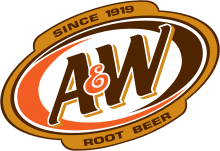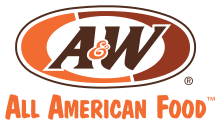A&W Root Beer
A&W Root Beer is a root beer brand primarily available in the United States and Canada that was founded in 1919 by Roy W. Allen.[1] When Allen partnered with Frank Wright in 1922, the partners combined their initials to create the A&W brand and inspired a restaurant chain, also founded that year. Originally, A&W Root Beer drinks sold for five cents.[2]
 | |
| Type | Root Beer |
|---|---|
| Manufacturer | Keurig Dr Pepper (United States, Worldwide) A&W Canada, The Coca-Cola Company (Canada) |
| Introduced | 1919 |
| Related products | Barq's, Mug Root Beer, Dad's Root Beer, Hires Root Beer, A&W Cream Soda |
| Serving size 8.1 fl oz (1 cup / 240 ml) | |||
| Servings per container | |||
| Amount per serving | |||
| Calories 120 | Calories from fat 0 | ||
| % Daily value* | |||
| Total fat 0 g | 0% | ||
| Saturated fat 0 g | 0% | ||
| Trans fat 0 g | |||
| Cholesterol 0 mg | 0% | ||
| Sodium 30 mg | 1% | ||
| Potassium 0 mg | 0% | ||
| Total carbohydrate 31 g | 10% | ||
| Dietary fiber 0 g | 0% | ||
| Sugars 31 g | |||
| Protein 0 g | |||
| Vitamin A | 0% | Vitamin C | 0% |
| Calcium | 0% | Iron | 0% |
| *Percent daily values are based on a 2,000‑calorie diet. Your daily values may be higher or lower depending on your calorie needs. | |||
Outside Canada, the rights to the A&W brand are owned by Keurig Dr Pepper, which in turn licenses the brand to the similarly named U.S.-based restaurant chain. A&W products are distributed via various U.S. bottlers. A&W Food Services of Canada, which is independent of both Keurig Dr Pepper and the U.S. chain, is responsible for the restaurants and the marketing of root beer products within the country,[3] with retail products bottled and distributed by the Coca-Cola Company. The U.S. variant is also sold as an import drink in Southeast Asia and Italy (where A&W has restaurants), as well as in Australia, Chile and other countries.
History
On June 20, 1919, Roy W. Allen opened a roadside root beer stand in Lodi, California, using a formula that he had purchased from a pharmacist.[4] He soon opened stands in Stockton, California as well as five stands in nearby Sacramento, home of the country's first drive-in featuring "tray boys" for curbside service. In 1920, Allen partnered with Frank Wright and the two combined their initials to create the A&W brand name. A mistaken notion is that the initials were derived from Alice and Willard Marriott; this may be because Marriott's first business was an A&W franchise.[5]
In 1924, Allen bought Wright's share, obtained a trademark, and began selling restaurant franchises. A&W was one of the first franchised restaurant chains in the United States. Franchise owners could use the A&W name and logo and purchased concentrated root beer syrup from Allen. By 1933, there were more than 170 A&W franchised outlets. There was no common menu, architecture, or set of procedures shared by the franchisees, and some chose to sell food with the root beer.[4]
Franchises struggled with labor shortages and sugar rationing during World War II, but following the war, the number of A&W outlets tripled as GI loans paved the way for private enterprise. Driven by the popularity of the automobile and the new mobile society, more than 450 A&W Root Beer stands were operating by 1950. In that same year, Allen retired and sold the business to Nebraskan Gene Hurtz, who formed the A&W Root Beer Company. The first A&W Root Beer outlet in Canada opened in 1956.
By 1960, the number of A&W restaurants swelled to more than 2,000. In 1963, the A&W Root Beer Company was sold to the J. Hungerford Smith Company, which had produced Allen's concentrate since 1921. In the same year, the first overseas A&W restaurant opened its doors in Guam.
In 1963, the company was sold to the United Fruit Company, then renamed the United Brands Company. In 1971, United Brands formed a wholly owned subsidiary, A&W Distributing Co., for the purpose of making A&W Root Beer available in bottles on the grocery shelf. After a test run in Arizona and California, the products were distributed nationally in the United States, along with sugar-free, low-sodium and caffeine-free versions. In 1974, A&W introduced "The Great Root Bear," a mascot that served as a goodwill ambassador for the brand.
In the late 1970s, A&W Restaurants was formed to manage restaurant franchising. It was bought in 1982 by A. Alfred Taubman.
The bear and its associated jingle became the basis of a long-running Canadian advertising campaign. The mascot was so successful that it was eventually adopted by the American A&W chain as well.
In 1986, A&W Cream Soda and A&W Diet Cream Soda were introduced and distributed nationally, followed in 1987 by the reformulation of A&W Sugar-Free as Diet A&W.
In October 1993, A&W Beverages was folded into Cadbury Beverages. That company would spin off its US beverages business as Keurig Dr Pepper in 2008.
In March 2005, A&W Root Beer appeared in a 20-ounce vintage bottle with graphics reminiscent of those of an old-fashioned root beer barrel. The brand's current tagline is "Classic American Refreshment Since 1919."
In July 2017, A&W Canada reformulated its root beer, dropping high-fructose corn syrup and some flavors from the recipe, substituting cane sugar, sarsaparilla root, licorice, birch bark and anise. They launched the new formula by declaring Free Root Beer Day, serving free root beer at all locations on July 22, 2017.[6]
Brands
- A&W Sugar-Free was introduced in 1974,[1] and reformulated as Diet A&W in 1987.[1]
- A&W Cream Soda and A&W Diet Cream Soda were introduced in 1986.[1]
- A&W Floats and Sunkist Floats were introduced in 2008.
- A&W TEN, a low-calorie root beer, began appearing in American supermarkets in the spring of 2013.
Promotions and contests
- Through eBay, A&W and Jim Belushi offered a trip to Los Angeles with a VIP pass to the "A&W Ultimate All-American Cookout and Concert" at the House of Blues.[7]
- In celebration of its 100th anniversary, A&W offered a free two-liter bottle of its root beer in exchange for taking the Family Fun Pledge, which asked participants to be "technology-free for one hour every Friday night this summer."[8]
The Great Root Bear
The Great Root Bear, also called Rooty, is the mascot for A&W Root Beer. It was first used in 1974 by Canada's A&W, and was adopted by the American chain in 1976. In a long-running television advertising campaign for the Canadian A&W chain, his theme was a tuba-driven jingle entitled "Ba-Dum, Ba-Dum", which was released as a single by Attic Records in Canada, credited to "Major Ursus", a play on the constellation name Ursa Major, which means "great bear". The famous Canadian composer and B.C. Hall of Fame enshrinee Robert Buckley helped compose the song. In the late 1990s, the Great Root Bear's role as mascot was reduced for the restaurant chain, ultimately replaced by "The Burger Family", although it still appeared in various capacities for the restaurants and on A&W Root Beer cases in Canada. In late 2011, the new ownership of A&W began using the mascot again, particularly in A&W's online presence.[9]
A&W Restaurants

Shortly after Allen bought out Wright's portion of the business, he began franchising the product. His profits came from a small franchise fee and sales of concentrate. There was no standard food menu for franchises until 1978. By 1960, the company had 2,000 stores.
In 1989, A&W made an agreement with Minnesota-based chain Carousel Snack Bars to convert that chain's 200 locations (mostly kiosks in shopping malls) to "A&W Hot Dogs & More".[10][11] Some A&W Hot Dogs & More locations are in operation today.
Many A&W locations that opened in the U.S. during the Yum! Brands ownership years (2002–2011) were co-branded with Yum!'s other chains—Long John Silver's, Taco Bell, Pizza Hut or KFC.
As of December 2011, A&W was bought by new ownership and its world headquarters was moved back to Lexington, Kentucky. Since then, in the United States and Southeast Asia, A&W has been a franchisee-owned company.[12]
References
- "Archived copy". Archived from the original on 2008-01-14. Retrieved 2007-12-22.CS1 maint: archived copy as title (link) – A&W root beer's official history
- Our Brands – Keurig Dr Pepper
- A&W Revenue Royalties Income Fund. "About A&W Food Services of Canada Inc". Archived from the original on 2011-07-06. Retrieved 2011-02-23.
- Smith, Andrew F., Encyclopedia of Junk Food and Fast Food, Greenwood Press, 2006. pp. 44–45.
- "The History of Root Beer".
- "A&W Canada is brewing root beer with natural ingredients". A&W Food Services of Canada. 5 July 2017. Retrieved 5 January 2019.
- eBay Bidders Can Vie for Trip to A&W Root Beer's 'Ultimate All-American Cookout and Concert' Featuring Jim Belushi and The Sacred Hearts Band; Proceeds From Online Charity Auction to Benefit John Belushi Scholarship Fund. – PR Newswire – HighBeam Research
- "Pledge to go Technology-Free and Create Family Fun with A&W Root Beer". www.prnewswire.com.
- Sloan, Scott. "A&W brings back its official spokesbear, Rooty | Daily Business Report". Kentucky.com. Retrieved 2013-12-30.
- A&W Root Beer — History & Collectables Archived November 28, 2007, at the Wayback Machine
- A&W prexy sets pace for growth in the '90's — A&W Restaurants; George Michel
- Franchise Opportunities Archived 2015-06-11 at the Wayback Machine A & W Restaurants.
Bibliography
- "A&W Root Beer — History". Archived from the original on 2008-08-27. Retrieved 2008-10-08.